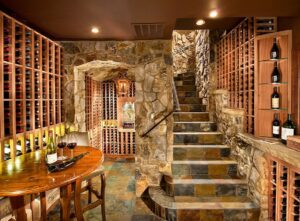
Have you ever dreamed of the summer being never-ending? Nothing is impossible! It is in your power to make it endless. Create a green, fragrant oasis in your home and enjoy it all year round. A picturesque winter garden filled with lush greenery – what could be better for relaxation after the boring monotony of the office interior?
Planning Your Winter Garden
Winter is the perfect time to decorate your garden. Here are some tips on how to decorate a winter garden:
1. Use natural materials in your landscaping. For example, use ground cover such as Hosta or Periwinkle instead of artificial plants. You can also use evergreen shrubs and trees that will keep your garden looking green all season long.
2. Choose interesting containers for your plants. Use old shoes, plastic buckets, or other recycled items to create interesting Winter garden containers.
3. Create a snow scene in your garden using fake snow and Christmas lights. Hang garland from the tree and arrange votives around the scene to create a festive atmosphere.
4. Add some greenery to your garden using evergreen branches and spikes from rose bushes or grapevines. These plants will add interest and height to your landscape while keeping it low maintenance.
Main Characteristics and Features

A winter garden is a complex system that includes a lot of engineering and technological solutions. The design allows you to create an optimal microclimate for various plants to provide competent care for them. In addition, a “green” room in an apartment or a country house can become a place for a comfortable pastime, rest, and relaxation.
Landscapes

There are various types of winter gardens, which are fundamentally different in purpose and design. Before embarking on implementing your idea, you need to decide which of the existing options you want to get. The most popular versions are:
- Residential
- Greenhouse
- Buffer
Residential

The winter garden, arranged in a heated room, was named residential. It has a microclimate that is equally comfortable for plants and the inhabitants of the house. It contains a sufficient number of representatives of the flora that c can cultivate all year round. Most often, such a winter garden becomes an extension of the dwelling and is used as a living room, dining room, billiards, or study. Plants are traditionally placed here in pots or pots. A convenient option is mobile structures that allow you to change the location of the plantings, depending on the degree of their love for the sun, the characteristic conditions of care, and design features.
Greenhouse
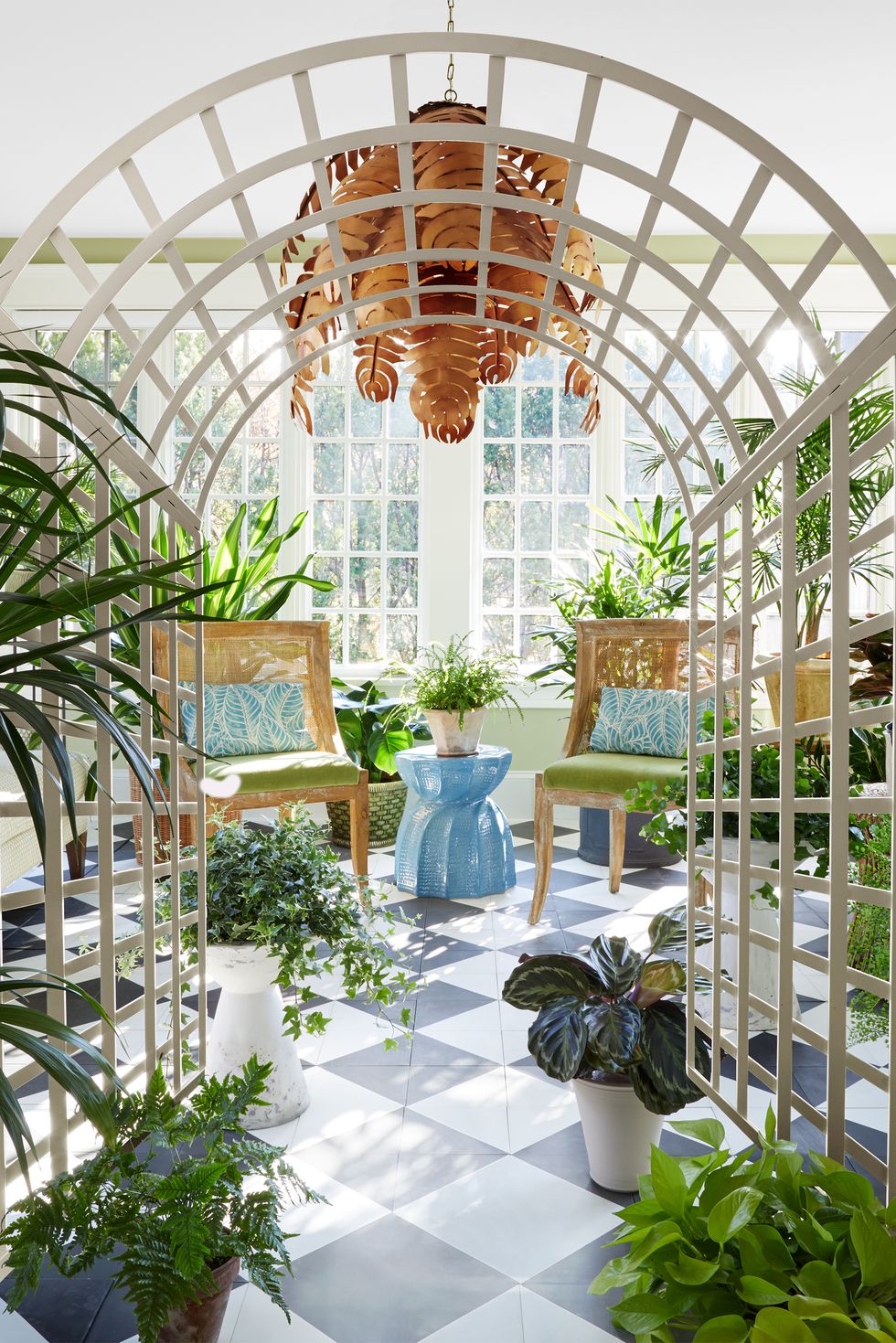
A greenhouse is a type of conservatory that serves only for growing plants and is not part of the living space. This is an unheated structure, which creates an ideal microclimate for various species, including exotic ones. Plants and soil are heated by infrared radiation from the sun, which penetrates the glass roof and walls. Flowers, vegetables, and fruits are often cultivated here. Many plants are transplanted into the ground after warm weather. The greenhouse is an indispensable construction for amateur gardeners, botanists, and agricultural complexes. However, this room cannot be called a zone of relaxation for the owners.
Buffer
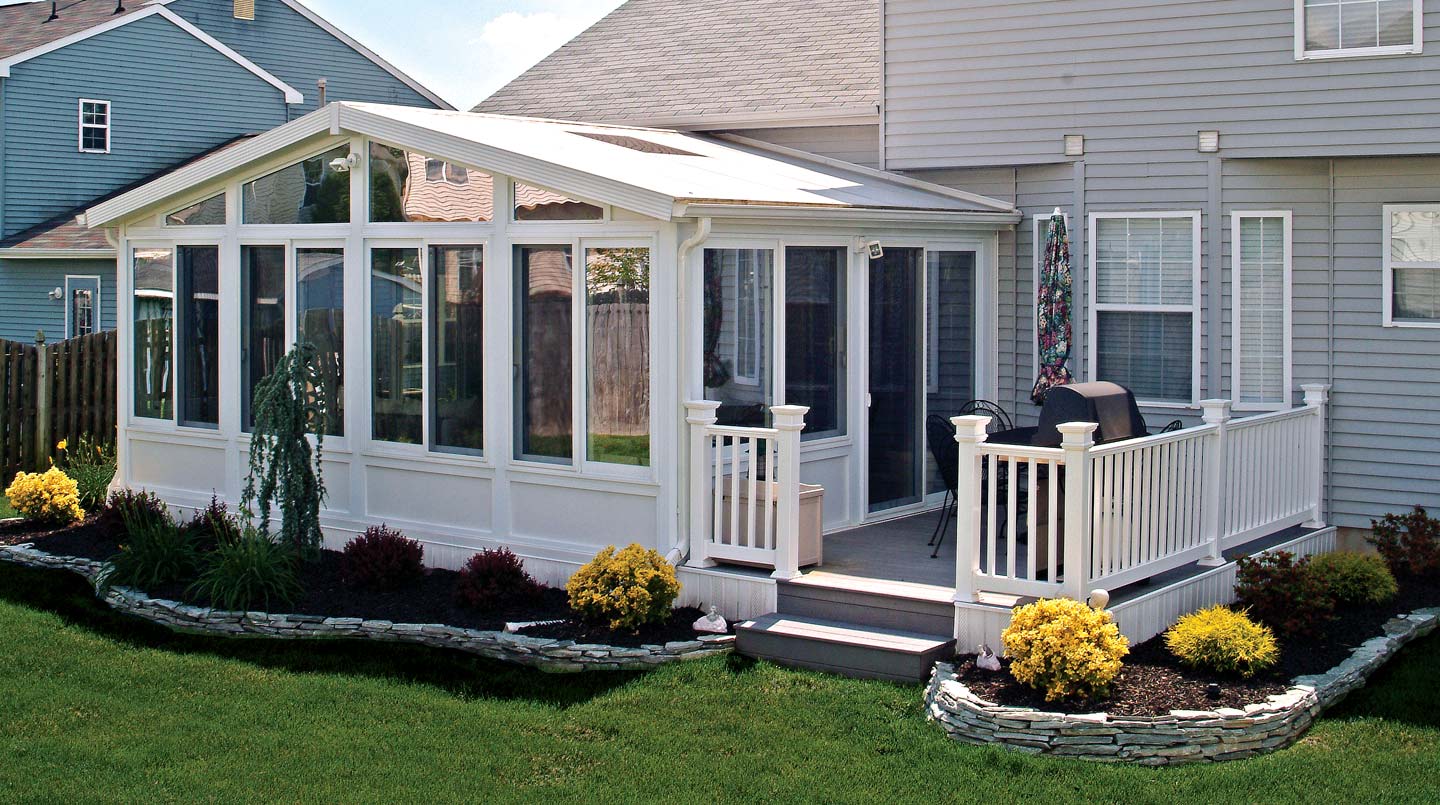
This home oasis extends the house that acts as a buffer between the living space and the street. This is a glazed unheated space. It cannot be used as a residential building, except when heating is not required – during the summer months. Panoramic glazing promotes heat accumulation. Thanks to this, a certain temperature is maintained inside the house itself, saving on heating costs. It is impossible to create a microclimate similar to a greenhouse here. The constantly opening door does not help to maintain it. Therefore, there are not many plants in the buffer garden, but you can arrange a wonderful area for recreation and entertainment here. Open windows will allow you to enjoy the view of the surrounding landscape.
Winter Garden Styles

Interior decoration of the premises, plants, decorative filling are of great importance for the concept of a winter garden. If you choose them thoughtlessly, you will receive the result unlikely to please you without agreeing with this or that style. Therefore, before you start creating your own green “corner,” you need to decide on its style, create a detailed project, and only after that start the arrangement. You can design the winter garden to imitate any natural landscape area or endowed with features of one of the architectural styles.
Classical
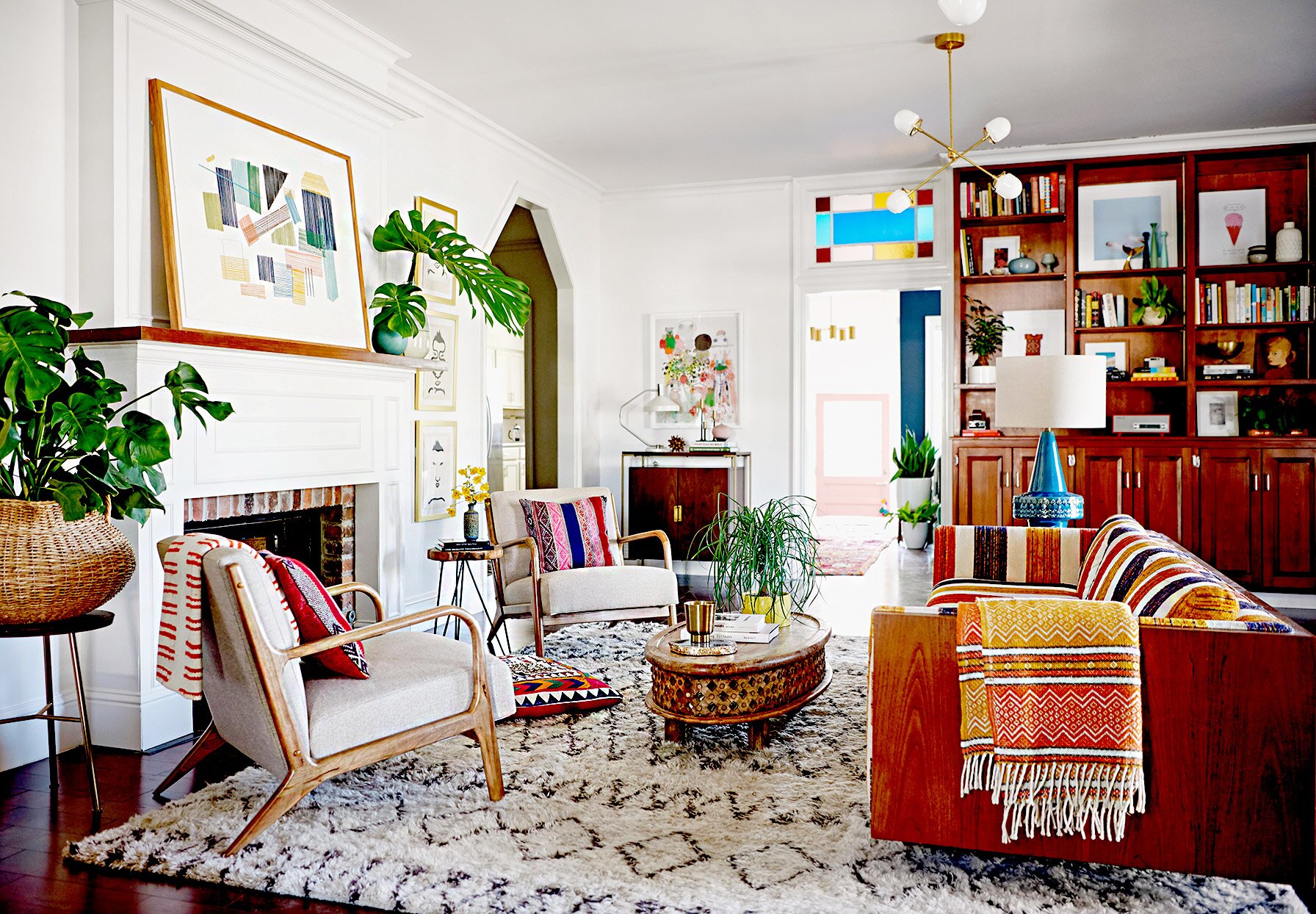
The main feature of the classic style is moderation. Decorations in neutral, soft colors will not distract attention. And the classic garden certainly has something to see. The rich colors of subtropical plants seem even brighter against the background of snow-white stucco moldings and marble. Usually, such rooms are filled with various arches, columns, pilasters. In addition to interior solutions, space is generously decorated with various statues and other works of art – frescoes, paintings. Mini fountains and water reservoirs can be used as additional decorations. And of course, we must not forget about classic furniture and lamps.
Japanese

A Japanese winter garden is a place where you can completely abstract yourself from the surrounding reality and surrender to the process of self-discovery. The philosophy of such a place gravitates towards minimalism and pronounced symbolism. To create the atmosphere of a Japanese garden, you can choose one of the most common directions:
- Kare Sansui is the so-called dry landscape. Such a landscape can hardly be called a garden. His characters are gravel, sand, and stones of various sizes. You will not find any plants and reservoirs here. The main purpose of this garden is to provide a space where a person can meditate, calm down and recover spent energy;
- Tsukiyama – known as a hilly garden. It is characterized by the reproduction of any terrain in miniature. In this case, a set of dwarf trees will symbolize a forest, a rocky embankment – mountains, and a small pond – the sea;
- Tea Ceremony Garden – allows you to relax and enjoy a cup of green tea among the picturesque plants. Avoid bright colors that have a stimulating effect on the psyche.
Country
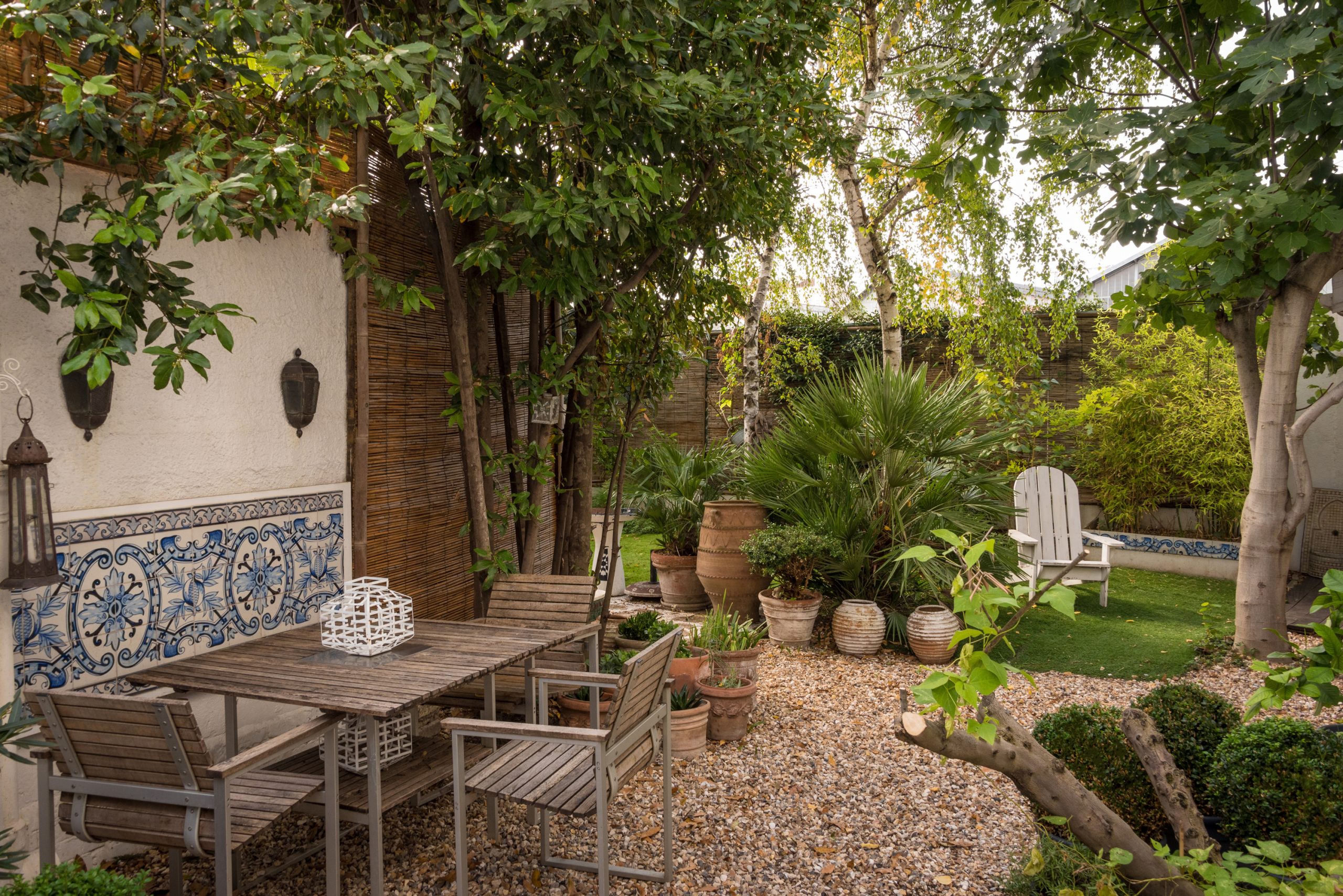
The country-style will absolutely suit any garden. The highlight of this place will be bright and lush flower gardens. They can combine completely different colors. The attributes of this style include natural lawns and accidentally emerging self-seeding in the form of wild-growing flowers or those that have unauthorizedly moved from the garden. Vegetables are an integral part of the garden, for example, bright and spectacular miniature pumpkins or squash, which can successfully replace flowers. You cannot imagine a country garden without wooden elements – rough, untreated benches, boxes for plants, old chairs, nets for vines, gazebos. The reservoirs have a natural look – overgrown with water lilies and duckweed, and they are often equipped with wooden walkways. You can use old watering cans, irons, wheels, and even a rocker as decor.
English

Nowhere have winter gardens gained such popularity as in England. It was the British who became the authors of two main types:
- Victorian – the garden is equipped with a 3 or 5-pointed bay window. A transparent five-pitched structure represents the roof of this room. Glass or transparent polycarbonate is used as a material for glazing;
- Edwardian – differs from the previous version in the simplicity of shape – rectangular structures with a conventional gable roof.
An English-style winter garden is a place for pleasant pastimes over a cup of tea, conversations, and women’s handicrafts. The main color combinations are green and cream, pink and white. There are also bright colors – yellow, blue, and details in shades of old gold ennoble the interior. Windows are of particular importance in the English greenhouse – they are decorated with various layouts, stained glass elements, and full-length curtains. A warm floor will make a soft carpet even more comfortable, and aged furniture will allow you to plunge into the atmosphere of antiquity, to isolate yourself from the hustle and bustle of the modern world.
Mediterranean

The hallmark of a design for a winter garden in this style is simplicity and clarity of lines. Most often, this is a room with a pitched roof adjacent to the house. Therefore, a veranda or a glazed terrace often plays the role of a greenhouse. This is a functional and solid room.
The distinctive features of the Mediterranean winter garden are the light walls and floor as if burned out under the sun’s burning rays. You can often find antique statues and ceramic vases here as decor. Forged benches, tables with glass tops, pergolas braided with climbing roses can act as a design element. Sundials and artificial ponds are also attributes of this style.
The traditional plants for the Mediterranean winter garden are juniper, real palms, citrus, pistachio, or olive trees from flowers – lavender, roses. And, of course, herbs are indispensable here – rosemary, saffron, coriander, basil are essential attributes of this style.
High Tech

A high-tech winter garden is the kingdom of glass, shiny metal, plastic, and regular geometric shapes. Lighting plays a huge role in such an interior. Glass floor lamps and chrome lamps are installed at different levels, allowing you to use the light as efficiently as possible. The practicality and functionality of each element are what characterizes this style. Comfortable and simple geometric furniture made of plastic, leatherette, metal will be appropriate here. Interior items with a metal frame will perfectly fit into space.
Modern

Expressive lines, laconicism, contrasting combinations, periodically repeating identical motifs are the distinctive features of the Art Nouveau garden. A single symbolic concept can be traced throughout the space. All design elements – crowns, lawns, paths – have smooth and apparent outlines. The expressiveness of the borders is enhanced by the contrast of color combinations – green lawn and gray paving of paths, light, and shadow. Plants for this garden should have large original leaves and a bizarre pattern of branches. The ornate shape of irises made them an integral part of the Art Nouveau style. In such a garden, one cannot do without expressive and graceful peonies and lilies.
How to Properly Decorate a Winter Garden: Step by Step Instructions

A professionally equipped winter garden will allow you to meet the summer whenever you return home. Thanks to verified technologies and care, you will constantly maintain the necessary microclimate here. Such a structure will require an impressive investment. But you can always do without unnecessary expenses if you get down to business on your own. The task of creating a winter garden with your own hands is not an easy task, so you will have to thoroughly “shoe.” We’ll have to familiarize ourselves with all the nuances of this complex and time-consuming process.
Choosing a Place for Arranging a Garden

Before proceeding with the design of the premises for the winter garden, it is necessary to determine the location of the building relative to the building. The side on which the structure will be located affects the temperature regime of the future garden and its microclimate.
Pros and cons of placing on either side:
- From the east – the most successful side, it allows you to create the most comfortable conditions for the plants and people located there – with a sufficient amount of light, such a building will not overheat;
- From the south – not a very good position for a garden, especially in summer. Plants will overheat, and additional ventilation will be required. On the other hand, in winter, such a structure will retain heat and save energy carriers;
- From the west – such structures can retain heat for a long time. In summer, this feature can turn into a minus;
- From the north – in such a room, heat accumulates poorly, and its return is accelerated. If this is the only possible option for arranging a green corner, you need to consider its heating carefully.
Wherever the winter garden is located, you should fill it with light, coziness, and comfort.
Determining the Shape of the Arranging
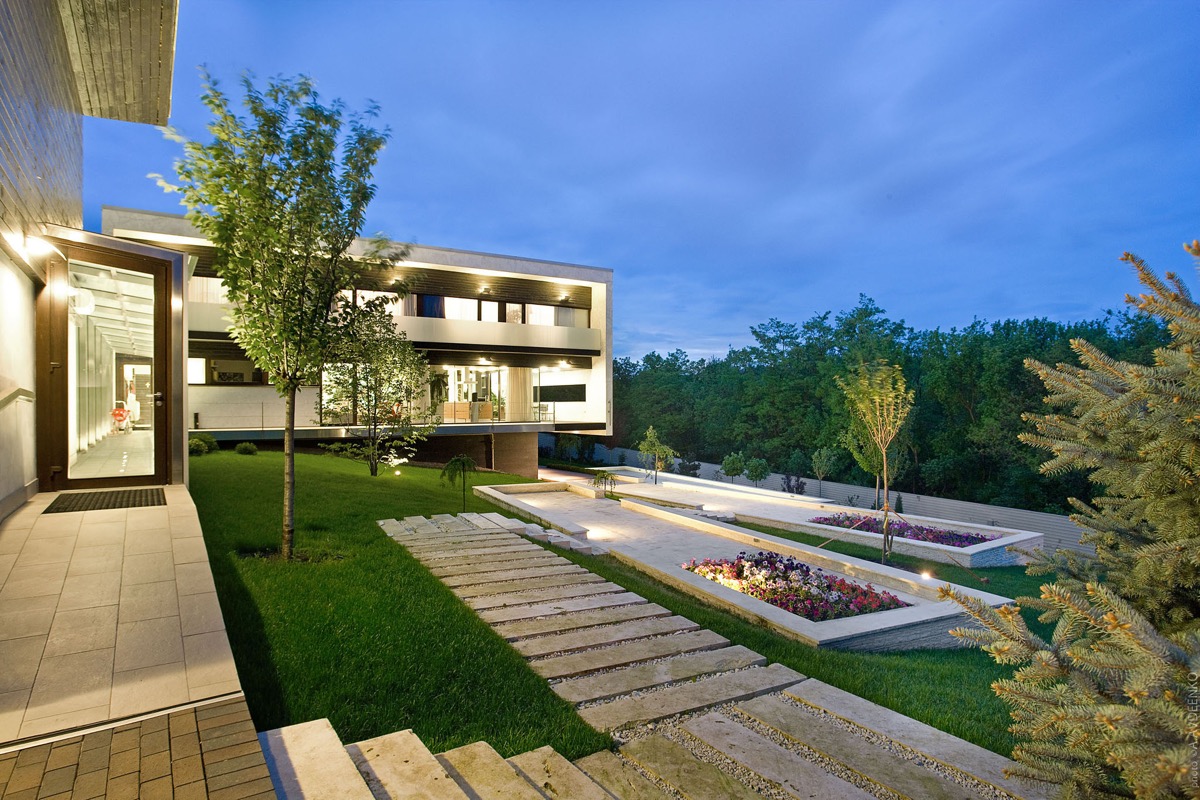
The shape of the building depends on the structural features of the building, the required size, placement – against the wall or in the corner, the chosen stylistic direction.
When designing a building, you can choose any of the already known formations. If none of the professionally developed versions suits you, come up with an original greenhouse model.
The main options for designs in shape
- Rectangular structure with a simple pitched roof. The walls and roof must be transparent. This is the most common modification of the winter garden, which is most often attached to the wall of the building.
- Corner structure – bends around the outer corner of the house.
- Quarter polygon – the building is built into the corner of the building from the street side.
- The rectangular structure, which is mounted in the corner of the house from the inside.
- A room formed by four walls and a gable roof.
- A three- or pentagonal structure with three and five-pitched roofs, respectively. Attached to the wall of the building.
What Material to Build From
The construction of the winter garden consists of a frame and glazing. The frame is most often made of aluminum. It is a lightweight and durable material that allows you to create a stable structure that does not threaten to collapse due to its own weight.
The choice of material for glazing depends on the purpose of the winter garden, its location to the building, and the financial capabilities of the owners. Most often, it is glass. In rare cases, transparent polycarbonate is used.
For greenhouses, tempered glass with a thickness of at least 6 mm with high thermal insulation performance is used. To prevent the windows from fogging up, heating is arranged. The advantage of tempered glass is its strength and safety. If it does break, it will fly into small fragments with non-sharp edges.
Double Glazed Windows
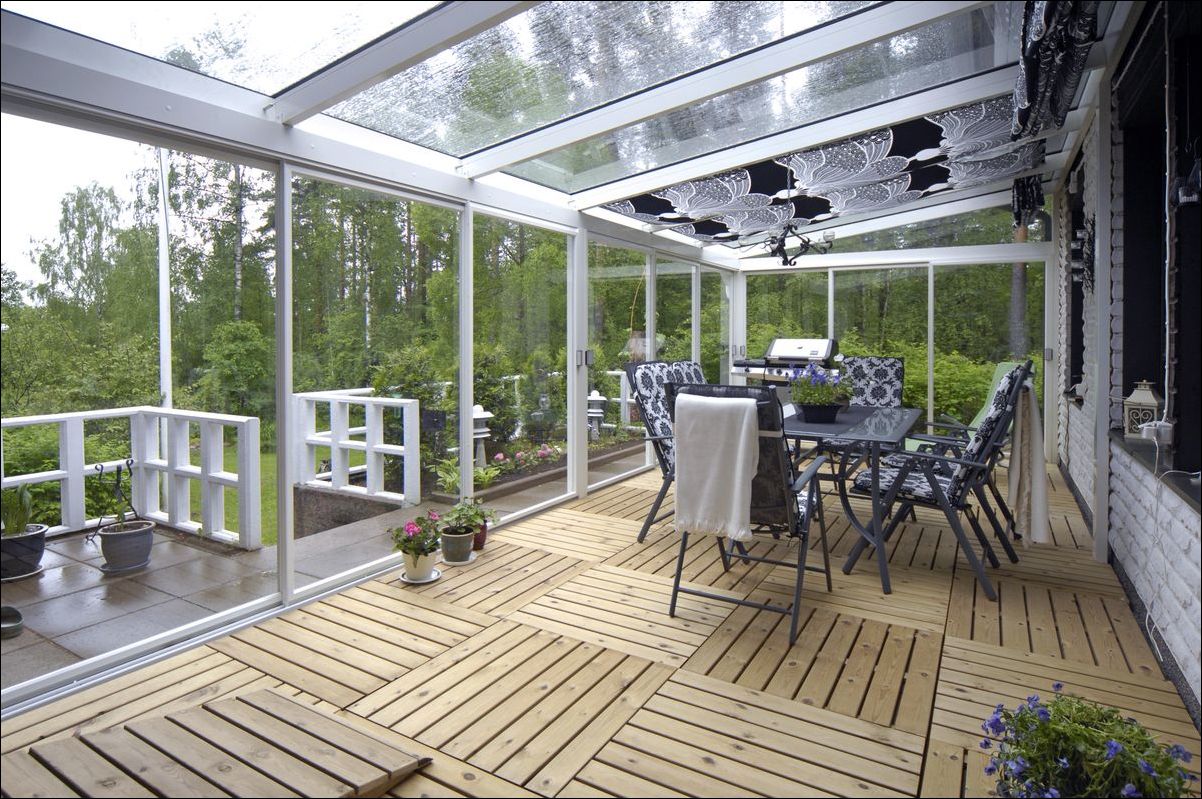
Today the market offers a variety of options for double-glazed windows. With their help, you can organize ideal heat and sound insulation, protect plants on a hot day from scorching rays. Inside, the glass unit is filled with inert gas, preventing heat from escaping from the room. But this is not the only plus of this material. Today you can pick up glasses supplemented with a variety of useful bonuses. Shockproof, hardened, soundproof, energy-efficient, mirrored – there are suggestions for any request.
Polycarbonate

This material is excellent at absorbing light and has an increased ability to heat insulation compared to glass. Polycarbonate is highly flexible and impact-resistant. True, its density is much worse than that of glass. The material can be matte, transparent, darkened, or colored. A variety of color options allows you to fit it into any design successfully. Flexible plastic can be shaped into interesting, curved shapes. Low weight can also be attributed to the advantages of the material.
If clear, sunny weather prevails in your area, it makes sense to choose dark polycarbonate. It will inhibit the effects of scalding rays and help protect your plants. Just keep in mind – the lack of light will have to be compensated for by additional artificial lighting.
There is injection molded and cellular polycarbonate. The heat-saving properties of the latter prevail. It is lighter. Therefore it is recommended to use it for the arrangement of roofs.
Pouring the Foundation and Installing the Frame

Despite the low weight of the aluminum profile frame, it is imperative to put the foundation under it. As a minimum, a shallow tape option. This will reduce the construction budget without reducing the bearing characteristics of the base and maintaining the reliability of the structure.
Stages of Foundation Construction
- Dig a trench, the width of which is 30 cm, and the depth is 60 along the perimeter of the future structure.
- Pour 15 cm of gravel or sand on the bottom of the trench.
- Tamp the formed pillow.
- Lay the reinforcement mesh on top of the compacted layer.
- Collect the formwork from the boards. The upper edge of the structure should protrude 6-10 cm from the ground.
- Fill the prepared form with cement mortar and leave it until it hardens completely.
- Remove the formwork.
The next step is making the frame
For work, you need four types of profile strips:
- Supporting
- Starting
- Front
- Specialized
Assembly Sequence
- Lay support profiles around the perimeter of the future structure. Their number depends on the shape of the winter garden. We form a base from them, fixing with anchors.
- Attach the starting strips to the wall of a private cottage and connect them to the base.
- Install facade profiles along the entire perimeter of the structure every 70-100 cm. It is necessary to leave a space under the opening of at least 100 cm in the future door. We fasten the strips with screws and anchors to the supports.
- Fasten the crossbars in the places of the vents for ventilation.
- Install supporting elements on top of the facade profiles along the perimeter of the building.
- Decorate a rafter structure with a slope of 30-45 degrees from specialized slats. We fix the profile at a distance of 50-70 cm.
- Install a water drainage system on the upper support bars.
- Seal all joints of the frame elements with each other, with the foundation and the wall using silicone.
Sheathing of the Frame of the Winter Garden
you must start the glazing process from the roof. Double-glazed windows are installed one by one on the formed rafters. A layer of rubber seal is placed between the metal strip and the glazing element. Then they are pressed tightly against each other using a special fixing beam. Wall cladding with double-glazed windows is done in the same way.
Polycarbonate is mounted on a metal frame using a point connection method using special self-tapping screws for metalwork. Hardware must be equipped with a special gasket – washer.
First of all, marking the attachment points on the material and the profile is made. The step between the screws can be from 25-70 cm.
Then the film is removed from the polycarbonate sheet, after which it is placed on the frame. At the joints of the panels, it is necessary to use a connecting profile. We fix the material by screwing in self-tapping screws in the designated places.
Roof Design and the Choice of Material for the Roof

If the frame of the winter garden is planned to be mounted from aluminum, you must choose the material for creating the roof with great care. The shape of the roof depends on the stability of the frame and the expected loads throughout the year. It must be designed with specific requirements in mind.
The roof structure can be:
- Single-pitched
- Gable
- Beveled
- Flat
- Hipped
- Multifaceted
The choice of form depends on the characteristics of the building itself. The roof can be made in a dome, cone, pyramid, sphere, and even a cube.
The structure of the roof influences the creation of indoor conditions. It affects the flow of heat, light, shade formation, ventilation efficiency, and even the organization of irrigation.
The following materials are used for arranging the roof – ordinary glass, with decorative inserts, darkened – with protection from the sun.
Winter Garden Heating

Heating is required in the residential conservatory. The system combines two types of heating devices – underfloor heating and conventional heaters placed on the floor. The function of the latter is to heat the façade double-glazed windows.
Installation of Water Supply and Irrigation Systems
Watering plants with a watering can is a pleasant but troublesome and time-consuming exercise. Automatic watering will allow you to maintain the required soil moisture level effortlessly.
If the water pressure allows, you can connect the automatic irrigation system directly to the water supply. This method is the least resource-intensive. You will need to organize a tie-in to the system, install a flushing module and special filters. The only negative is that the water from the system may be too cold for irrigation.
A more expensive way is an automatic system, consisting of a container with water and a special pump that creates pressure.
Electrical Wiring and Lighting

To ensure the operation of all systems, a power supply is required. Therefore, even at the design stage, it is necessary to determine the appropriate type of wiring, organize its installation, and provide the required number of sockets and switches.
Light is something that is never enough in a winter garden. Lack of light has a detrimental effect on plants and slows down their growth. Therefore, it is necessary to fill the room with additional light sources.
We carefully choose the lamps – the growth of plants depends on them. Incandescent, conventional fluorescent options are not the best choice for a garden. For this purpose, photo lamps of two types are optimal – LED and fluorescent. They were designed specifically to illuminate the “inhabitants” of greenhouses.
Ventilation System Equipment

Ventilation is an indispensable element of a winter garden. It helps maintain a certain level of humidity and temperature in the room, provides oxygen, and purifies the air from carbon dioxide. The ventilation system must be of two types:
- Natural – carried out due to vents and hatches in the roof of the building;
- Limited– in the form of electric fans.
Protecting the Winter Garden from Strong Solar Radiation

Lack of light is harmful to plants, but too much light is much more dangerous. In summer, when the sun is especially active, it is necessary to provide the garden with reliable protection.
There are two types of structures that are effective for saving plants from solar radiation:
- Internal – fabric curtains, Japanese panels, roll curtains, blinds. You can use bamboo or plastic structures. Metal blinds are not suitable, as they affect the temperature regime inside the room – they quickly heat up and spread heat for a long time. In addition, during the operation of forced ventilation, they vibrate and create unnecessary noise;
- External – glazing with reflective mirror effect, tinted glass, awnings, awnings. These materials prevent rays from reaching the inside of the garden so that the temperature remains at the same level.
Plants for the Winter Garden and Decoration

There are three main types of plants used in winter gardens:
- Tropical
- Subtropical
- Desert
When choosing a green filling for a home “oasis,” you should not mix representatives of different geographic zones in the same room. For each of them, it is necessary to organize a certain microclimate.
Tropical Plants
The tropical option is the most popular type of conservatory. It originated in the Baroque era. The incredible decorativeness of tropical plants allows you to create truly fabulous compositions. In such a garden, fountains, ponds, sculptures, flowerpots, and other design elements look organic. Among such an impressive landscape, a recreation area in benches, armchairs, sofas will perfectly fit.
Types of tropical plants that can be used:
- In any variation, Alocasia will decorate any interior thanks to the wonderful spreading leaves of all kinds of shades.
- Dieffenbachia Seguin – the owner of white-green leaves, an excellent option for decorating the first tier of a tropical garden.
- Lyre ficus – its incredible leaves can shelter a resting person from the sun’s rays.
- Striped calathea is also an excellent choice for filling a tropical greenhouse.
Subtropical Plants
The main difference between these gardens from the previous ones is the prevalence of representatives of the citrus family. They are also characterized by a variety of cacti, succulents, palms. They cannot compete with tropical plants in terms of the picturesque flowers, but they are less whimsical and calmly tolerate the lack of heat. Sometimes, for the plants to begin bearing fruit, the temperature in the room has to be specially lowered.
Which of the subtropical plants is not averse to settling in a winter garden?
- Mandarin is a familiar representative of citrus fruits. It will delight you with beautiful flowering and delicious, fragrant fruits.
- Citron is a short shrub with white delicate flowers and spectacular and large fruits.
- Strelitzia – in autumn, it is covered with bright flowers that resemble multi-colored parrots.
- Livistona Chinese – the owner of large fan-shaped leaves. The front surface of the sheet reflects sunlight, as it is covered with a waxy coating.
Plants of Desert Regions
Desert gardens are not as popular, and yet they have their fans. To arrange such a garden, you do not have to cover the entire room floor with sand. You can create the right atmosphere with the help of desert plants – succulents. These are any varieties of cacti, fat women, scarlet, and other similar owners of thick fleshy leaves and sharp thorns. They are quite decorative in themselves, and some can delight you with wonderful flowers. Plants of this type are unpretentious, and they come in various shapes, sizes, and colors. With their help, you can create a picturesque and extraordinary green “corner.”
The Main Areas of the Garden

The purpose of the winter garden is not only plant breeding but also recreation. Therefore, it is important to divide it into special zones. This will contribute to the proper care of green “pets,” easy access to them, a comfortable pastime for the owners.
When arranging a garden, first of all, you need to deal with the allocation of zones – recreational, communicative, and decorative.
Decorative – there will be plants, flower arrangements, landscape decor elements selected in a certain style – a decorative reservoir, a fountain, a rocky hill, sculptures.
Recreational – and area equipped with furniture. Here you can place a sofa, armchairs, a table, various benches. Rocking chairs, serving tables on wheels are perfect. The recreational area is designed for quiet contemplation of plants, relaxation, and reception of guests.
Communication area – an area that provides a passage to admire the beauty of plants at close range.
How to Decorate a Winter Garden on a Balcony or Loggia in an Apartment

If you do not have a summer cottage where it is easy to find a place to install a glass structure, do not be discouraged. You can easily create an impromptu winter garden on your own balcony or loggia. Before purchasing plants, the room needs to be prepared – to install glazing and insulate. It is necessary to think over the lighting and organize the places for connecting electrical appliances – underfloor heating, lamps, ventilation system. To maintain a microclimate and a favorable temperature for plants, you can install an air conditioner. Windows should be equipped with roller blinds or pleated blinds so that you can adjust natural light.
Conclusion
The main purpose of the winter garden is not at all growing flowers and seedlings. It is created to enjoy the contemplation of beautiful plants brought from distant countries and admire the combination of skillfully selected decorative elements. Here you can relax under the murmur of water in a miniature fountain and plunge into romantic dreams.

